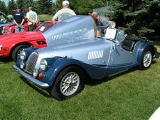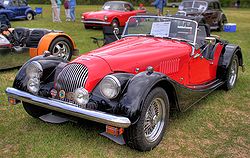
Morgan Plus 8
Encyclopedia
The Morgan Plus 8 is a sports car built by British car makers Morgan
between 1968 and 2004. Its instant and enduring popularity has been credited with saving the company and keeping the company famous during the 36 years of its manufacture. Among Morgan enthusiasts, it is deeply associated with Peter Morgan, the owner-chairman behind its design.
215 cid V8
, purchased from GM-Buick in 1967. Chassis and wings were developed in stages to accommodate larger tyres to handle the power. The original 1968 Plus 8 was 57 inches (1,447.8 mm) wide and the last was 64 inches (1,625.6 mm) (with an optional "widebody" at 67 inches (1,701.8 mm)) For several years in the 1960s the Plus Eight was the fastest-accelerating UK production car.
To mark the 35th year of production of its Plus 8, MMC released a commemorative 'Anniversary Edition'.
and Marcos
- to use the engine, which Rover had only just made available in the P5B saloon.
The early Plus 8s used the 215 block (renamed the 3.5 L by Rover) with a compression of 10.5:1 fueled by two SU HS6 carburettors. In 1973, the compression was dropped to 9.25:1 and power dropped with it. However in 1976, the compression was increased to 9.35:1 when an improved version of the block developed for the Rover SD1
was adopted and after 1981 this was fueled by two Stromberg carburettors, and the power increased.
At the end of 1983, the company offered a EFI version using a Bosch L-Jetronic based system. With the added power (204 bhp) and low weight, the Plus 8 was, according to the magazine road tests of the day, able to best a Porsche up to 90 mi/h. In 1990, a 3.9 L version of the block was added using the Lucas 14CUX
fuel injection system.
In 1996, a 4.6 L version found its way into the car as an option, still using the 14CUX system. From 2000, all Morgan Plus 8s were fueled by the GEMS system used on the Land Rover Discovery II.
In the US, a way was found to keep importing Morgans after 1974. From 1974 to 1992, all imported Morgans (of which 98% were Plus 8s) to the United States
were converted by independent dealers, especially Bill Fink, to run on propane
as fuel to pass the U.S. emissions regulations.
When the Rover Group
re-certified their V-8 engine for use in the Range Rover
SUV sold in the U.S., Morgan made a gasoline-powered +8 available with the same engine in the same tune and with the same anti-emission devices. As safety regulations continue to change, Morgan was again challenged in 2006 to meet the new structural requirements announced by the NHTSA in 2000. A request for an exemption to the law on airbags was refused and the importation of traditional (classic) Morgans ceased.

Morgan Motor Company
The Morgan Motor Company is a British motor car manufacturer. The company was founded in 1910 by Harry Frederick Stanley Morgan, generally known as "HFS" and was run by him until he died, aged 77, in 1959. Peter Morgan, son of H.F.S., ran the company until a few years before his death in 2003...
between 1968 and 2004. Its instant and enduring popularity has been credited with saving the company and keeping the company famous during the 36 years of its manufacture. Among Morgan enthusiasts, it is deeply associated with Peter Morgan, the owner-chairman behind its design.
Design
The Plus 8 was based on the chassis of the Plus 4, to which it added the Rover alloy blockRover V8 engine
The Rover V8 engine is a compact V8 internal combustion engine with aluminium cylinder heads and cylinder block, originally designed by General Motors and later re-designed and produced by Rover in the United Kingdom...
215 cid V8
V8 engine
A V8 engine is a V engine with eight cylinders mounted on the crankcase in two banks of four cylinders, in most cases set at a right angle to each other but sometimes at a narrower angle, with all eight pistons driving a common crankshaft....
, purchased from GM-Buick in 1967. Chassis and wings were developed in stages to accommodate larger tyres to handle the power. The original 1968 Plus 8 was 57 inches (1,447.8 mm) wide and the last was 64 inches (1,625.6 mm) (with an optional "widebody" at 67 inches (1,701.8 mm)) For several years in the 1960s the Plus Eight was the fastest-accelerating UK production car.
To mark the 35th year of production of its Plus 8, MMC released a commemorative 'Anniversary Edition'.
Engines
All Plus 8s engines were based on the Buick 215 which had been bought by Rover. Morgan was the first of a succession of sports car makers- including the likes of TVRTVR
thumb|right|240px|TVR No.2, the oldest surviving TVR, located at [[Lakeland Motor Museum, Newby Bridge, Cumbria]]TVR was an independent British manufacturer of sports cars. Until 2006 it was based in the English seaside town of Blackpool, Lancashire, but has since split up into several smaller...
and Marcos
Marcos (automobile)
Marcos was a British sports car manufacturer. The name was a combination of founders Jem Marsh and Frank Costin.-History:Marcos was founded in Luton, in Bedfordshire, England, in 1959 by Jem Marsh and Frank Costin. Frank Costin had earlier worked on the De Havilland Mosquito fighter-bombers and...
- to use the engine, which Rover had only just made available in the P5B saloon.
The early Plus 8s used the 215 block (renamed the 3.5 L by Rover) with a compression of 10.5:1 fueled by two SU HS6 carburettors. In 1973, the compression was dropped to 9.25:1 and power dropped with it. However in 1976, the compression was increased to 9.35:1 when an improved version of the block developed for the Rover SD1
Rover SD1
Rover SD1 is both the code name and eventual production name given to a series of large executive cars made by British Leyland or BL through its Specialist, Rover Triumph and Austin Rover divisions from 1976 until 1986....
was adopted and after 1981 this was fueled by two Stromberg carburettors, and the power increased.
At the end of 1983, the company offered a EFI version using a Bosch L-Jetronic based system. With the added power (204 bhp) and low weight, the Plus 8 was, according to the magazine road tests of the day, able to best a Porsche up to 90 mi/h. In 1990, a 3.9 L version of the block was added using the Lucas 14CUX
Lucas 14CUX
The Lucas 14CUX is an automotive electronic fuel injection system developed by Lucas Industries and fitted to the Rover V8 engine in Land Rover vehicles between 1990 and 1995...
fuel injection system.
In 1996, a 4.6 L version found its way into the car as an option, still using the 14CUX system. From 2000, all Morgan Plus 8s were fueled by the GEMS system used on the Land Rover Discovery II.
United States sales
For almost two decades during the 1950s and 1960s, North America took the greater bulk of Morgan production. Popularity in the UK and Europe had greatly fallen during that era. The era ended with the advent of the strong emission and structural laws. Luckily, the failure of the modern looking +4+ and the arrival of the powerful Plus 8 rekindled interest in the home market in the whole line.In the US, a way was found to keep importing Morgans after 1974. From 1974 to 1992, all imported Morgans (of which 98% were Plus 8s) to the United States
United States
The United States of America is a federal constitutional republic comprising fifty states and a federal district...
were converted by independent dealers, especially Bill Fink, to run on propane
Propane
Propane is a three-carbon alkane with the molecular formula , normally a gas, but compressible to a transportable liquid. A by-product of natural gas processing and petroleum refining, it is commonly used as a fuel for engines, oxy-gas torches, barbecues, portable stoves, and residential central...
as fuel to pass the U.S. emissions regulations.
When the Rover Group
Rover Group
The Rover Group plc was the name given in 1986 to the British state-owned vehicle manufacturer previously known as British Leyland or BL. Owned by British Aerospace from 1988 to 1994, when it was sold to BMW, the Group was broken up in 2000 with the Rover and MG marques being acquired by the MG...
re-certified their V-8 engine for use in the Range Rover
Range Rover
The Range Rover is a large luxury four-wheel drive sport utility vehicle produced by British car maker Land Rover. The model, launched in 1970, is now in its third generation...
SUV sold in the U.S., Morgan made a gasoline-powered +8 available with the same engine in the same tune and with the same anti-emission devices. As safety regulations continue to change, Morgan was again challenged in 2006 to meet the new structural requirements announced by the NHTSA in 2000. A request for an exemption to the law on airbags was refused and the importation of traditional (classic) Morgans ceased.
Gearboxes

- 1968-1972 Moss Gearbox, a 4-speed manual transmission with synchromesh 2nd, 3rd and 4th.
- 1972-1977 Rover 2000 Gearbox, a 4-speed all-synchromesh manual transmission
- 1977-1995 Rover LT77, a 5-speed all-synchromesh manual transmissionManual transmissionA manual transmission, also known as a manual gearbox or standard transmission is a type of transmission used in motor vehicle applications...
- 1995-2004 Rover R380, a 5-speed all-synchromesh manual transmission

